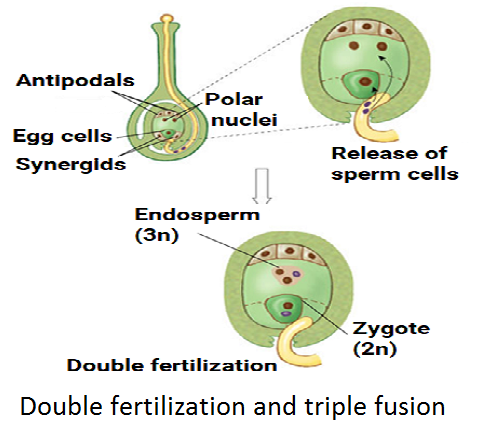Double Fertilisation and Triple Fussion


Double Fertilisation and Triple Fussion
The process was demonstrated for the first time by Nawaschin in 1898 in Lilium and Fritillaria. The most important and unique characteristic feature of angiosperms is the participation of both male gametes in the act of fertilisation. The pollen tube releases the two male gametes into the cytoplasm of a synergid. One male gamete fuses with the egg cell to form a diploid zygote. This process is called syngamy or generative fertilisation.
The diploid zygote finally develops into the embryo. The second male gamete fuses with the two polar nuclei or secondary nucleus in the central cell to form the triploid Primary Endosperm Nucleus (PEN). The process is called triple fusion as three haploid nuclei are involved in the fusion.
After triple fusion, the central cell becomes the Primary Endosperm Cell (PEC) which gives rise to the endosperm while. the zygote develops into the embryo. As two fusions, syngamy and triple fusion occur in an embryo sac, the phenomenon is known as double fertilisation.

Students / Parents Reviews [10]
About Abhyas metholodology the teachers are very nice and hardworking toward students.The Centre Head Mrs Anu Sethi is also a brilliant teacher.Abhyas has taught me how to overcome problems and has always taken my doubts and suppoeted me.

Shreya Shrivastava
8thOne of the best institutes to develope a child interest in studies.Provides SST and English knowledge also unlike other institutes. Teachers are co operative and friendly online tests andPPT develope practical knowledge also.

Aman Kumar Shrivastava
10thA marvelous experience with Abhyas. I am glad to share that my ward has achieved more than enough at the Ambala ABHYAS centre. Years have passed on and more and more he has gained. May the centre flourish and develop day by day by the grace of God.

Archit Segal
7thAbhyas Methodology is very good. It is based on according to student and each child manages accordingly to its properly. Methodology has improved the abilities of students to shine them in future.

Manish Kumar
10thMy experience with Abhyas is very good. I have learnt many things here like vedic maths and reasoning also. Teachers here first take our doubts and then there are assignments to verify our weak points.

Shivam Rana
7thIt was a good experience with Abhyas Academy. I even faced problems in starting but slowly and steadily overcomed. Especially reasoning classes helped me a lot.

Cheshta
10thIt was good as the experience because as we had come here we had been improved in a such envirnment created here.Extra is taught which is beneficial for future.

Eshan Arora
8thIt has a great methodology. Students here can get analysis to their test quickly.We can learn easily through PPTs and the testing methods are good. We know that where we have to practice

Barkha Arora
10thMy experience with Abhyas academy is very good. I did not think that my every subject coming here will be so strong. The main thing is that the online tests had made me learn here more things.

Hiya Gupta
8thBeing a parent, I saw my daughter improvement in her studies by seeing a good result in all day to day compititive exam TMO, NSO, IEO etc and as well as studies. I have got a fruitful result from my daughter.
